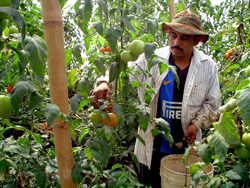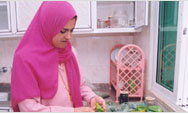You are here » Home » Telling Our Story
Success Story
Salvadoran farmers improve their crops and lives with new skills
A Time to Reap

| |
Photo: Fintrac-IDEA/Melvin Medina
|
|
Miguel Ortiz works at a greenhouse tomato harvest in Jayaque, La Libertad, in southwestern El Salvador.
“I was almost broke, but things started changing as soon as I finished the training ... [In] my three greenhouses, I grow tomatoes and bell peppers — I can look forward to the future,” said Ricardo Ulises Llovera, a farmer who participated in the USAID program.
|
Dora Rodriguez had almost given up trying to make a living growing vegetables on her one hectare plot in El Refugio, in Ahuachapan, western El Salvador. The final straw came when pests ate through her entire crop of peppers — she nearly gave up on farming. But then she heard about a USAID program to teach farmers new agricultural practices, like using improved seedlings, drip irrigation, protective netting, proper plant nutrition and pest management techniques. She joined the program, and her next harvest was a huge success: Dora’s revenue for vegetable sales for the year jumped to more than $28,000.
Dora is one of 500 farmers in El Salvador who learned new techniques from a USAID-funded project that began after two earthquakes shook the country in 2001. After the disaster, USAID helped communities get back on their feet, create jobs, and boost incomes. USAID also began teaching farmers how to successfully grow crops that were in high demand: fruits and vegetables. El Salvador’s imports of fruits and vegetables weighed in at a hefty $110 million annually. To take advantage of local demand for these products, USAID funded training workshops and taught farmers and businesses about growing, handling, processing horticulture, as well as how to conduct market research and develop their businesses effectively. Farmers also learned about integrated pest management and pesticide safety protocols.
Farmers switched from low-value crops such as maize, beans, and low-grade coffee or sugar cane to a diversified mix of vegetables in high demand in local markets. The results have been dramatic. Some farmers who completed the program saw sales grow tenfold, from about $2,100 to $22,300 per year. Together, the farmers have generated more than $18.5 million in new vegetable and fruit sales and created nearly 6,700 new permanent and seasonal jobs. This effort has already changed the lives of many and will continue to improve the lives of many more Salvadoran farmers and their families.
Print-friendly version of this page (440kb - PDF)
Click here for high-res photo
Back to Top ^ | 

